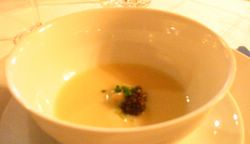Blog Day 2005
 You might read the logo at left and conclude that today is 310 grams day, but it actually is not. No, today is Blog Day 2005, and a closer examination of the logo - from just the right distance, with one eye half closed, and perhaps a hand covering the other eye - reveals both the word "blog" and the numerical sequence "3108," as in today's date the way most of the planet abbreviates it. The idea behind this grand event is for bloggers the world over to identify five blogs that are relatively new (or new to them), and then to post a short description of each on their own blogs. So, without further ado, here are five great blogs that I have recently discovered:
You might read the logo at left and conclude that today is 310 grams day, but it actually is not. No, today is Blog Day 2005, and a closer examination of the logo - from just the right distance, with one eye half closed, and perhaps a hand covering the other eye - reveals both the word "blog" and the numerical sequence "3108," as in today's date the way most of the planet abbreviates it. The idea behind this grand event is for bloggers the world over to identify five blogs that are relatively new (or new to them), and then to post a short description of each on their own blogs. So, without further ado, here are five great blogs that I have recently discovered:In Praise of Sardines: Brett is a culinary school graduate and former professional cook who started his outstanding Bay-Area-based blog just a few months ago. Brett's writing is crisp and interesting, and his blog covers a variety of topics including great recipes, the best local food purveyors and farmers, restaurants worth checking out, and food-related adventures he had on a recent trip to Spain and New York. Brett's unique mix of formal training, professional experience, and industry relationships makes him an invaluable voice in the food blogging community.
Small Farms: Tana Butler, who lives in Santa Cruz County, has a deep appreciation for farms, farmers, sustainable agriculture, fresh produce, farmers' markets, and good food, and her excellent blog immediately imparts her devotion and passion to everybody who stops by. Indeed, there's a fantastic quote on her front page that all who enjoy fine dining would be wise to heed: "behind every great chef is at least one great farmer." And immediately below that quote is a picture of the renowned Harold McGee rapt with attention at something Tana is saying, proving that you should be too!
Nosh: This blog out of Germany has actually been around for quite some time, but I regrettably did not discover it until just recently. Mia provides enticing recipes with beautiful pictures, typically weaving in a story or two about how the dish or its ingredients relate to past memories or present experiences. Nicely-written, informative, and distinctive - what more can one ask for?
Zarzamora: Steve Cooper is the gentleman behind this well-designed blog out of London, and he explains the basic premise right at the top of his front page: "is it possible to learn how to cook simply by being married to a cook and loitering in the kitchen?" Steve's writing style is excellent and entertaining, and he conveys information in such a way as to keep the interest of beginners and more experienced cooks alike. He offers up wonderful recipes, great pictures, and even background information regarding dishes - all with a healthy dose of humor.
The Novato Experiment: Jennifer started this unique blog just this past summer, when she left her Presidio Heights apartment in San Francisco for a brand new life 30 miles north in Novato. In addition to chronicling her efforts to figure out where people eat in her new town, Jennifer writes in real-time about the various lifestyle adjustments she is undertaking as a consequence of her move. From strip mall sushi to life without Rechiutti chocolates, Jennifer's posts are amusing, wistful, or both - making for a great blog.
Finally, I would be remiss if I failed to mention four favorite blogs that I would have included in the above list but for the fact that I have known about them for quite some time: Becks & Posh, Gastronomie, Food Musings, and The Delicious Life. Sam, Fatemeh, Catherine and Sarah, respectively, are generating some of the best food writing around today.
I encourage you to check out all of the above blogs as soon as you get the chance!











